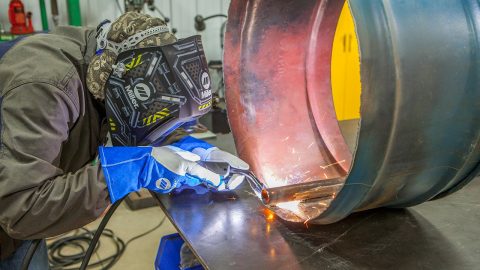
In today’s industrial production, there are many welding technologies suitable for each different application, from TIG, MIG welding, arc welding to oxygen gas welding. The following article will provide additional information on the most common welding technologies in production.
Conceptually, welding is the process of fusing two pieces of materials together by supplying heat from the outside to melt the materials to make a unified whole to serve certain needs. Most information shows that welding is mainly used for materials made of metal. However, other materials such as plastic can also be welded. In this article, we only mention the common welding technologies applied when working with metal materials.
Arc welding
True to its name, arc welding uses electric arc to melt metals before fusing them. The arc current combines two pieces of material together using two electrodes (the electrodes usually do not corrode).
Electric arc can reach very high temperatures up to 3500° C, very effective in melting metals including steel containing high carbon content. This method also uses gas as a protective cover for the weld because external air can cause oxidation of the weld that reduces its quality.
The following are the most common applications of arc welding in industrial production:
– Ship building.
– Car manufacturing
– Build
– Mechanical engineering
– Use when welding at high speed.
– Easy welding with basic materials.
– Lightweight device, easy to carry.
– Can weld with direct current (DC) and alternating current (AC).
– High welding temperature.
– Ineffective when working with thin materials.
– Requires high skills.
– Cannot be used with metals like Aluminum or Titanium.
MIG Welding (Metal Insert Gas Welding)
MIG welding is another welding method that also uses electric arc during welding. However, the difference in MIG welding compared to the above method is that MIG welding uses a corrosive electrode to connect the two materials together. This corrosive electrode is a piece of metal that provides the bonding material, which melts in the arc tank and acts as a binder.
In MIG welding, the electrode is easily fused to connect the material, so MIG welding is widely used when welding two pieces of the same material. The gas used in this technology is inert gas, which is pumped in and wrapped around the groin during welding to ensure the weld is not affected by outside air.
Common applications of MIG welding
– Used in most metal healing applications.
– Manufacturing compressed air cylinders and steel structure works.
– Automobile manufacturing technology and home improvement industry.
– Create high quality welds.
– When welding less spun around.
– Use effectively when welding similar materials.
– Can use automatic or semi-automatic welding.
– Ineffective when welding outdoors.
– Difficult to weld with thick materials.
– Material preparation process takes effort.
(To be continued)Productivity and Quality Office